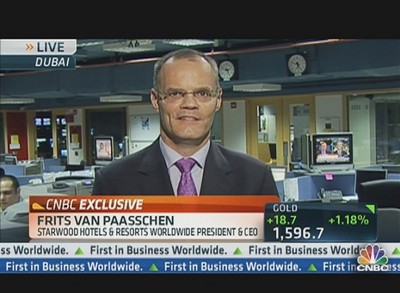If there's one U.S. industry that's found a home in China, it's the lodging business.
Building ramped up leading to the 2008 Beijing Olympics and 2010 Shanghai World Expo, one-time incentives for growth in marquee destinations. Now the expansion is especially visible in so-called second- and third-tier cities most Americans have never heard of. But with more Chinese joining the middle class and staying overnight for business or pleasure – the sector is hot, maybe too hot, experts say.
Proliferation of Super 8 hotels in China? You bet.

Starwood CEO Eyes Future Growth in DubaiFrits Van Paasschen, President & CEO of Starwood Hotels & Resorts Worldwide
Growth in Second-Tier Cities
If you happen to make your way to Luohe, a city of some 1 million residents in China's central plains, you can tour Coca-Cola's second largest bottling plant in China. Or consider exploring the region's food production scene including Henan Province's famous ham.
And while you're there, you can stay at a Four Points by Sheraton – the first internationally branded hotel in the city. Four Points opened its doors in December last year.
As urban infrastructure such as highways and airports has developed, so too has the demand for accommodation in places like Luohe, one of 170 cities in China with more than a million people. They're often called China's second-tier cities. The country's wealth, in other words, is spreading beyond first-tier metropolises such as Beijing, Shanghai and Shenzhen, where the hotel industry has had a firm footprint for years.
Starwood's Growth Strategy
Starwood has been growing its international portfolio including China.
"The biggest brand in our pipeline, both in the Middle East and Africa, and frankly everywhere around the world is still Sheraton, followed by Four Points by Sheraton," Frits Van Paasschen, chief executive of Starwood Hotels & Resorts, told CNBC in March.
As part of Starwood's growth strategy, Sheraton temporarily relocated headquarters to China two years ago to understand the regional market first-hand. They've repeated that strategy more recently by setting up camp in Dubai for a month as it's opening 50 properties across the Middle East and Africa, Van Paasschen said.
Key Players
As of the end of 2012, Starwood has nearly doubled its China footprint to roughly 116 hotels, adding about 50 properties during the last two years.
Another big hotel player in China is InterContinental Hotels Group, whose brands include Holiday Inn and Crowne Plaza brands IHG. They manage Intercontinental, Crowne Plaza and Holiday Inn brands. IHG closed 2012 with some 190 properties in great China including Hong Kong, and 160 in the pipeline.
Plus, Hilton ended 2012 with some 34 properties, up substantially from just four properties four years ago.
Other key players in the China market include Wyndham, which includes Super 8, Ramadas, Days Inn properties and Howard Johnson properties.
Marriott International has about 60 hotels in Asia including its Renaissance and Ritz-Carlton brands, with plans to develop 75 more.
The Rising Middle Class
All the key hotel chains are zeroing in on the same trend: China is one of the fastest growing tourism markets in the world. Hotel revenue in China reached $39 billion in 2012, up 6.3 percent over five years, according to IBIS World, a market researcher. By 2017, IBIS projects revenue will soar to $56.2 billion.
To be clear, China has been a market for western hotel companies for more than two decades. Among the first to break ground was Starwood with its Great Wall Sheraton property in Beijing.
Fast forward and more Chinese are entering the middle class – with discretionary income to enjoy a relatively new leisure activity, traveling throughout China.
By 2020 half of urban Chinese households will have disposable income between $16,000 to $34,000, up from just six percent in 2010, according to a McKinsey & Company report. At that point, many households will be able to afford travel.
And Western hotels are there to capitalize on that newly acquired income and demand.
IHG is already seeing more local residents exploring China and staying at its hotels, IHG CEO Richard Solomons told CNBC last year. "Our business is over 80 percent domestic travel now," he said. "It's no longer just overseas sort of business people just flying in. It's very much domestic with a growing middle class and growing domestic wealth."
China Hotels Overheating?
Despite the region's lodging boom, there are concerns.
Though many hotel groups are growing revenue in China, occupancy rates remain low relative to developed destinations, according to STR Global, a hotel industry research firm.
But the occupancy rates are not a major concern, say hotel management companies, because they are planning for the next 10 to 20 years.
No matter what the short-term outlook for China's hotels, it's clear the Chinese traveler has arrived.
By 2015, China will have 100 million outbound travelers, the largest in the world, according to Starwood figures. That's more than the number of annual visitors to France, the No. 1 international tourist destination.
Source: CNBC (includes video)
















